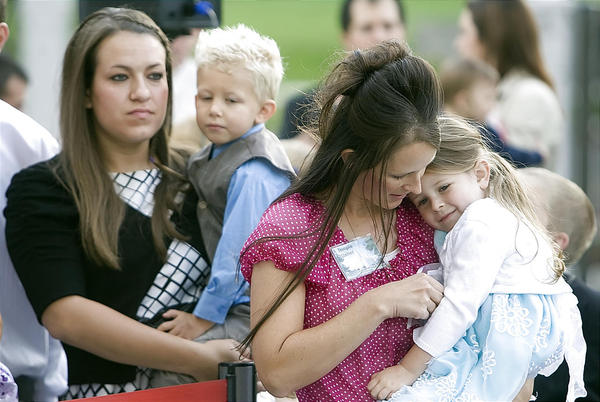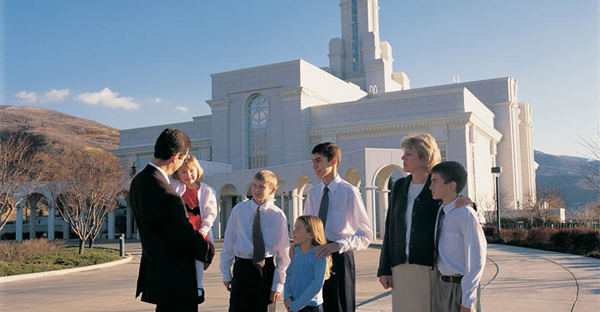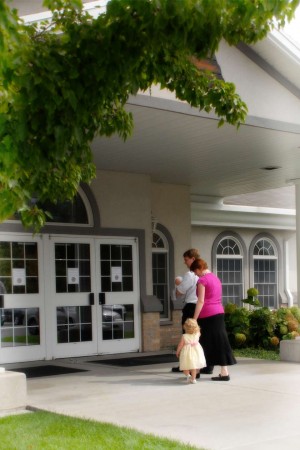A recent Gallup poll named the Provo and Orem area of Utah the most religious metropolitan area in the United States.
In the poll, 77 percent of the residents in the area considered themselves “very religious,” which means they said they attend religious services every week or nearly every week and consider religion an important part of their daily living.
 The large population of members of The Church of Jesus Christ of Latter-day Saints—often mistakenly called the Mormon Church—that live in the area certainly influenced the ranking.
The large population of members of The Church of Jesus Christ of Latter-day Saints—often mistakenly called the Mormon Church—that live in the area certainly influenced the ranking.
“‘We currently have about 90 percent Latter-day Saints in this area,’” said Richard Bennett, Associate Dean of Religious Education at Brigham Young University. “‘You have BYU here, with 32,000 students—most who go to church—and UVU, a public university with many who also attend church.’”
Bennett also said the Church’s Missionary Training Center, the Provo Temple, and the construction of the Provo City Center Temple draw Mormons to the area. “‘This survey is merely one small testament to the religiosity of the culture.’”
Although Provo-Orem has been nicknamed “Happy Valley” or “Milk White” because of the population of Latter-day Saints, the religiosity of the area reflects other religions thriving there as well.
“‘There is a strong connection to religion here, predominantly among LDS, but also among many Christian churches, and it’s only continuing to grow,’ said Bill Young, a pastor at The Rock Church, a Christian church in Provo. ‘I love it. It’s a great place to be, a great place to raise a family.’”
“In Provo, community transcends the church,” said Logan Wolf, pastor of New Morning Church in Provo. “Everywhere you go, everybody is friendly and courteous. A lot of this is due to a shared system of beliefs.”
Provo-Orem rose above the nation’s other top religious areas in the South: Montgomery, Alabama, and Jackson, Mississippi each ranked 64 percent; and Birmingham-Hoover, Alabama, ranked 56 percent. Wolf, originally from North Carolina, said, “When you think of strong religious sectors, you think of the Bible Belt.” However, he was not surprised that the Provo-Orem area topped the list.
Members of the Church of Jesus Christ believe in Jesus Christ and consider Him the head of their church. The Bible is an essential part of their canon of scripture, and Latter-day Saints regularly read, study, and teach from the Bible.
With “more church buildings per square block than any place in the state,” as Bennett described Provo-Orem, residents could easily see a parallel with heavily populated Christian areas of the South.
Marie Cornwall, a professor of sociology and women’s studies at Brigham Young University noted that “one can be religious in other traditions without attending every week.” Latter-day Saints, however, believe that attending Church meetings each week and serving in the Church are essential to their commitment to Jesus Christ, His gospel, and their membership in His church.
Utah tied for second place with Alabama for the most religious state. Mississippi topped the list at 58 percent. Salt Lake City, the capitol of the state of Utah, ranked only 47 percent very religious. Although the city is headquarters for the Church of Jesus Christ, the Gallup analysis of the survey concluded that the number “likely reflects the tendency for Salt Lake City residents to be more urban, less Mormon than the other Utah metro areas.”
The Ogden-Clearfield area, located about 30 minutes north of downtown Salt Lake City, ranked ninth in the poll, with 55 percent of the respondents saying they were very religious.
Boulder, Colorado, and Burlington, Vermont, tied for least religious city in the poll with only 17 percent of their residents calling themselves very religious. Other cities ranked the least religious are located generally in the northeast and along the Pacific Coast.
The survey found that “31 percent of Americans were nonreligious, seldom attending religious services and not considering religion an important part of daily life.” Twenty-nine percent considered themselves to be “moderately religious, attending services, but finding religion to be less important.”
Gallup surveyed residents in 189 metropolitan areas of the United States.
The Gallup analysis concluded that “residents in some areas and cities—namely, those in the south and in Utah—are two or three times as likely to be very religious as those living in cities in the northeast, the northwest and other western locations.”
Reference:
Gallup poll: Provo named most religious metropolitan area in the U.S.
This article was written by Paula Hicken, a member of The Church of Jesus Christ of Latter-day Saints.
 Paula Hicken was an editor with the Neal A. Maxwell Institute for Religious Scholarship from 2000 to 2013. She earned her BA degree in English from Brigham Young University. She edited Insights, the Maxwell Institute newsletter, and was the production editor for Faith, Philosophy, Scripture, Hebrew Law in Biblical Times (2nd ed.), Third Nephi: An Incomparable Scripture, and was one of the copy editors for Analysis of the Textual Variants of the Book of Mormon. She also helped manage the Maxwell Institute intellectual property and oversaw rights and permissions. She has published in the Ensign, the Liahona, the LDS Church News, and the FARMS Review.
Paula Hicken was an editor with the Neal A. Maxwell Institute for Religious Scholarship from 2000 to 2013. She earned her BA degree in English from Brigham Young University. She edited Insights, the Maxwell Institute newsletter, and was the production editor for Faith, Philosophy, Scripture, Hebrew Law in Biblical Times (2nd ed.), Third Nephi: An Incomparable Scripture, and was one of the copy editors for Analysis of the Textual Variants of the Book of Mormon. She also helped manage the Maxwell Institute intellectual property and oversaw rights and permissions. She has published in the Ensign, the Liahona, the LDS Church News, and the FARMS Review.
Additional Resource:
About paulah
Paula Hicken was an editor with the Neal A. Maxwell Institute for Religious Scholarship from 2000 to 2013. She earned her BA degree in English from Brigham Young University. She edited Insights, the Maxwell Institute newsletter, and was the production editor for Faith, Philosophy, Scripture, Hebrew Law in Biblical Times (2nd ed.), Third Nephi: An Incomparable Scripture, and was one of the copy editors for Analysis of the Textual Variants of the Book of Mormon. She also helped manage the Maxwell Institute intellectual property and oversaw rights and permissions. She has published in the Ensign, the Liahona, the LDS Church News, and the FARMS Review.
Twitter •



